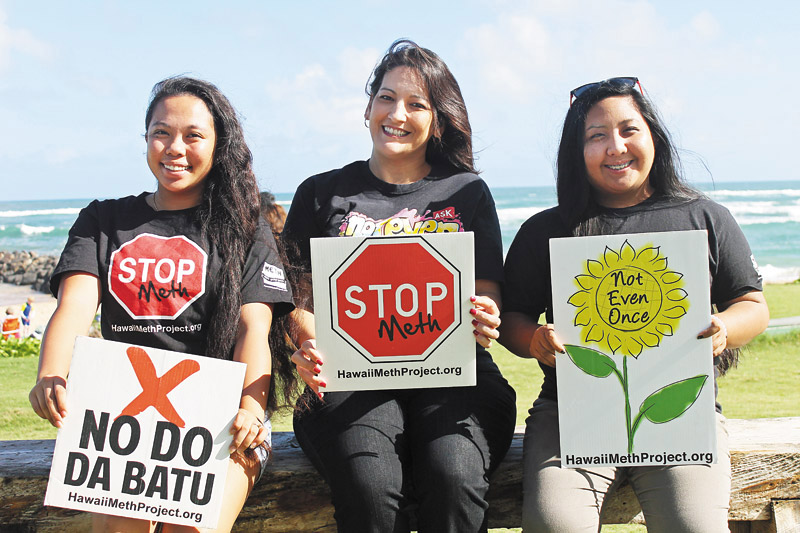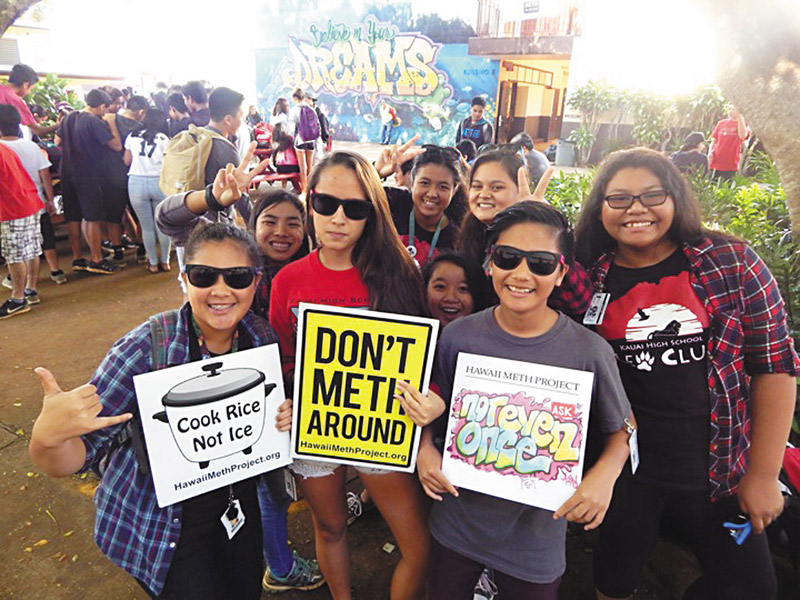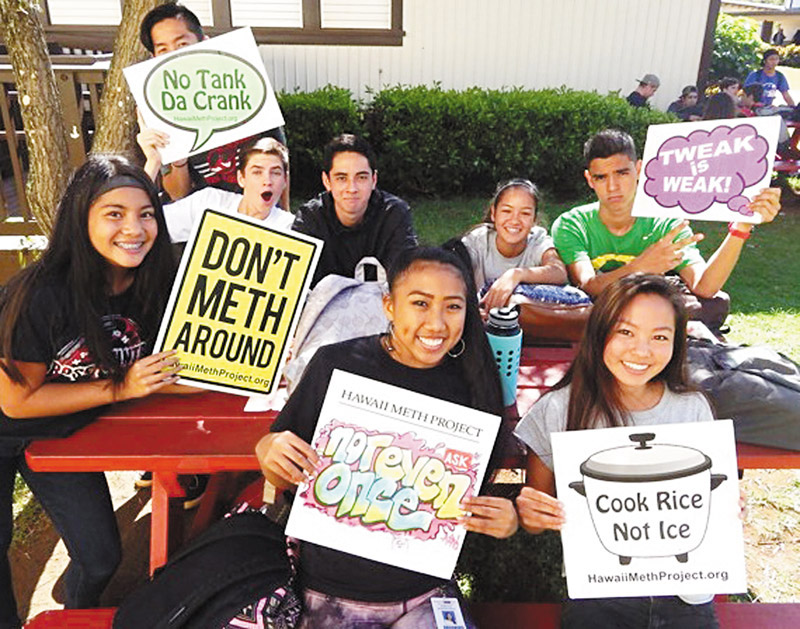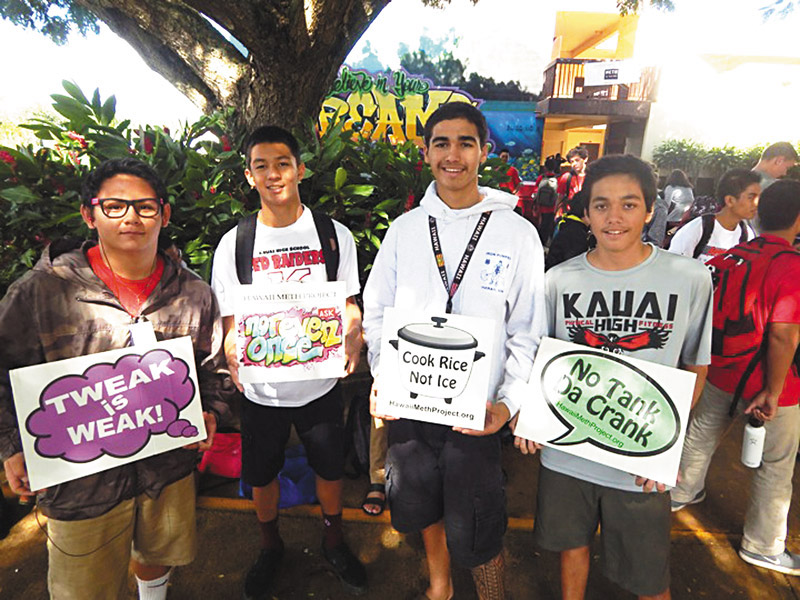Not Even Once
By COCO ZINGARO
Erica Owan and Cassandra Mateo-Corpuz are determined to impart an important message to their peers about the dangers of methamphetamine. The Kauai High School seniors are encouraging other students to steer clear of the hazardous drug with the slogan: “Not Even Once.” They are ambassadors for Hawaii Meth Project and serve on the statewide Teen Advisory Council.
“Meth is a very powerful substance, so a lot of times, when people try it for the first time, they get hooked,” explains Owan. “Our motto is ‘not even once’ because it will lead you into that dangerous pathway.”
She knows just how damaging the effects of the drug can be — some of her family members were involved in drug use.
“It really damaged all of their relationships between each other,” she says. “I just wanted to help prevent others from having to face that.”
Mateo-Corpuz also is familiar with the devastation that follows a serious drug addiction. Her brother was a meth addict during his 20s, while she was between the ages of 8 and 12, and she unfortunately was exposed to its detrimental aftermath.
“He would bring me around his friends every night and every day he had the chance,” she says. “He always had an excuse to get out of the house to do meth.”
Now her brother is serving time in jail in Arizona.
“I pretty much lost my brother because of one bad choice he made,” she says.
She also lost out on a happy and carefree childhood, but that hasn’t stopped her from trying to help others avoid the same mistakes.
“What’s rewarding for me is knowing that if I help and can stop one person from doing it, it will stop them from hurting their families and feeling the same way I did,” she says.
The teens have a “Not Even Once” club and recruit student volunteers to help spread their message as far and wide as possible, including at community gatherings such as Waimea Town Celebration, “and any other events we can get our hands on,” says Owan.
They set up booths to educate teens and keiki about the multitude of emotional and physical repercussions of meth use, and even have games, including a modified version of “Operation” that identifies all the horrible things the drug can do, such as self-inflicted skin damage during hallucinations.
Their efforts seem to be working, as the most recent statistics from the survey, “Meth Use and Attitudes,” conducted by Hawaii Meth Project, indicate that 96 percent of students show a “strong disapproval” for using meth and that a majority of those surveyed statewide are aware of the organization.
“We want to see this continue. To be a part of breaking the cycle, we have to keep the message out there,” says Georgi DeCosta, executive director of Hawaii Meth Project, who is proud of the 19 members of the Teen Advisory Council and the work they do.

Kauai Teen Advisory Council members for the Hawaii Meth Project, Cassandra Mateo-Corpuz (left) and Erica Owan (right) with Georgi DeCosta
Though meth use usually begins with young adults between the ages of 19 and 26, Hawaii Meth Project’s prevention programs are aimed at changing youths’ understanding and sentiments toward the drug before they are lured by its temptations.
“Sometimes it’s peer pressure, but sometimes it’s that people don’t know what else to do,” says Mateo-Corpuz, explaining why so many young adults in Hawaii gravitate toward meth. “Some people reach a very low point
in their life, and then they see their friends doing it, and if they want to feel better about themselves, that’s what they start doing.”
DeCosta, who lives on Oahu but regularly visits Kauai to work with the teens, knows firsthand how tempting it is to start using drugs — when she was younger, she abused meth and heroin.
“I made a lot of bad choices,” she admits. “I regret a lot of the things that I went through. I’m so blessed to have this opportunity to maybe help others, young people, to not go through those same things I did because it was pretty painful for me, my family and those around me.”
She also feels lucky to have survived the addiction “in one piece,” as so many others do not. She knows plenty of people who sadly succumbed to overdoses, including the father of her children as well as their aunt, who died from organ failure because of meth use — she was only 30 years old.
“It’s extremely damaging what this drug can do. It’s unlike any other substance,” she says. “It really does destroy people’s mind, body and soul.”
So the nonprofit, which was founded in 2009, continues to spread a message of utmost importance.
“If we can do positive peer pressure to make people stay away from it, then we can help someone potentially continue their dreams instead of them being crushed by this drug,” says Owan.
Hawaii Meth Project will be recruiting new Teen Advisory Council members for the next school year (2016/2017). Applications will be available soon. Visit hawaii.methproject.org for updates and more information.
cocomidweek@gmail.com
COCO ZINGARO PHOTO








